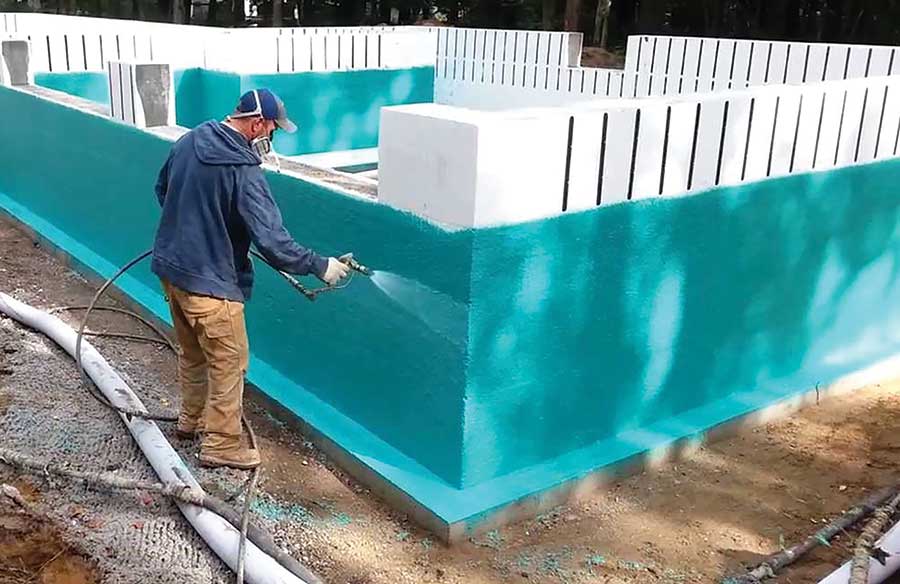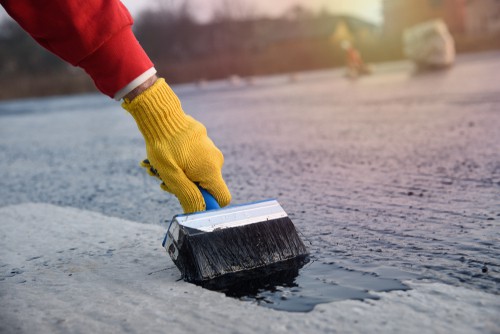How Landscape drainage Omaha Safeguards Your Foundation from Water Runoff
Just How Waterproofing Functions: A Thorough Appearance at Strategies and Technologies
Waterproofing is essential for protecting structures from moisture-related damages. It involves different techniques and technologies that develop obstacles versus water invasion. Typical approaches, such as compacted clay, exist side-by-side with modern technologies like liquid-applied membranes. Comprehending the nuances of these strategies is vital for effective application. The efficiency of any waterproofing remedy pivots not just on the strategies made use of however likewise on recurring maintenance and evaluation. What are the crucial variables that affect long-term efficiency?
Comprehending the Basics of Waterproofing
Waterproofing is an important procedure that safeguards frameworks from water intrusion, which can bring about substantial damages in time. This technique entails the application of various products and techniques created to create an obstacle versus moisture. The key goal is to stop water from permeating surface areas, which can cause degeneration, mold growth, and structural instability.Various elements affect the choice of waterproofing approach, consisting of the kind of framework, its location, and environmental conditions. Recognizing the physics of water activity and the residential or commercial properties of different materials is important in choosing a reliable waterproofing solution.Effective waterproofing not only safeguards buildings but also enhances their long life and honesty. Typically, it is integrated right into the style stage of building and construction to ensure comprehensive security. As recognition of water-related concerns grows, the importance of comprehending waterproofing fundamentals comes to be significantly clear to designers, contractors, and home owners alike.
Typical Waterproofing Techniques
Conventional waterproofing techniques have been used for centuries, depending on reliable strategies and products to secure structures from water damages. One of the oldest approaches entails the usage of clay, which, when compressed, produces a natural barrier against moisture. Additionally, bitumen, a sticky, black product originated from petroleum, has been employed for its water-resistant buildings, usually put on roof coverings and foundations.Another strategy entails the application of lime-based plasters, which give a breathable layer that enables moisture to escape while preventing water access. Thatch roofing, a typical technique still seen in some cultures, supplies exceptional waterproofing as a result of its firmly loaded straw layers.Moreover, making use of stone and block has actually projected, as these products are inherently resistant to water when appropriately mounted. In general, standard waterproofing techniques stress the importance of selecting suitable products and construction methods to improve sturdiness against water invasion.
Modern Waterproofing Technologies
Innovations in modern waterproofing technologies have reinvented the way frameworks are secured from water damage. Ingenious strategies such as liquid-applied membranes and advanced sealants have improved the performance and adaptability of waterproofing solutions. These modern technologies permit seamless application, lowering the risk of leaks and guaranteeing complete insurance coverage over intricate surfaces.Moreover, the assimilation of clever technologies, such as moisture sensors and automated tracking systems, makes it possible for real-time assessment of waterproofing performance. This aggressive technique promotes timely upkeep and decreases long-lasting fixing costs.Additionally, developments in spray-applied coatings provide quick application and outstanding bond, adjusting to different substrates while offering durable security. Strategies like polymer-modified systems better enhance versatility and toughness, making them appropriate for varied settings. On the whole, contemporary waterproofing innovations not only reduce water invasion but also add to the durability and sustainability of frameworks, noting a considerable change in the market.
Materials Utilized in Waterproofing
The efficiency of waterproofing solutions greatly relies on the products used in their application. Various materials are used to produce barriers versus water ingress, each with one-of-a-kind buildings fit for different atmospheres. Typically made use of materials consist of membranes, finishings, and sealants.Liquid-applied membranes, often made from polyurethane or acrylic, create a smooth barrier that adjusts to complex surfaces. Sheet membranes, commonly created from rubber or polycarbonate, offer resilience and are ideal for bigger areas. In addition, cementitious waterproofing products, composed of cementitious substances, supply outstanding adhesion and flexibility.Sealants made from silicone or polyurethane are essential for joints and joints, making sure comprehensive defense. Advanced materials, such as geo-composite membrane layers, incorporate several features, improving performance. On the whole, the selection of waterproofing materials is essential in accomplishing lasting and efficient water resistance, customized to particular project requirements and environmental conditions.
Typical Applications of Waterproofing
Waterproofing plays an important role in different industries, ensuring the long life and integrity of structures. Typical applications consist of property services that shield homes, industrial infrastructure that safeguards services, and commercial settings that need robust protection against dampness. Understanding these applications highlights the relevance of waterproofing in keeping both safety and capability throughout various atmospheres.
Residential Waterproofing Solutions
Numerous property owners face difficulties with wetness intrusion, making reliable household waterproofing solutions vital. Different approaches exist to address this problem, including inside and outside waterproofing systems. Inside solutions typically include the application of sealants and finishes to basement walls, which help avoid water infiltration. Outside approaches commonly consist of the installment of drain systems and water resistant membranes that divert water away from the foundation.Additionally, house owners may think about sump pumps to remove water accumulation and dehumidifiers to control moisture degrees. Appropriate grading and the usage of rain gutters also play a vital role in managing water circulation around the home. By applying these strategies, property owners can substantially minimize the risk of water damage and mold growth, guaranteeing a dry and safe living setting.

Business Facilities Security
Efficient waterproofing remedies play a critical role in the defense of business infrastructure. Basement waterproofing Omaha. These techniques are important for safeguarding structures, parking frameworks, and bridges from water damage, which can jeopardize structural honesty and cause costly fixings. Typical applications include the installment of membranes, layers, and sealants that produce obstacles against wetness infiltration. Locations such as basements, roofings, and exterior walls are commonly prioritized to assure longevity and resilience. Additionally, waterproofing systems can enhance power efficiency by avoiding water-related problems that may lead to mold development and wear and tear. By executing durable waterproofing measures, homeowner can secure navigate here their financial investments and preserve operational efficiency, eventually adding to the total sustainability of business centers
Industrial Applications Review
While various sectors encounter distinct obstacles, the need for reputable waterproofing remedies continues to be a constant in commercial applications. Industries such as production, building and construction, and power frequently come across environments where moisture exposure can threaten structural honesty and functional effectiveness. web link In producing facilities, waterproofing is crucial for safeguarding equipment and materials from water damages. In building and construction, it safeguards structures and cellars against groundwater seepage. The power sector depends on waterproofing for the defense of tools in hydroelectric plants and overseas frameworks. In addition, food handling markets use waterproofing to ensure hygiene and compliance with safety and security criteria. Generally, efficient waterproofing remedies are important for improving resilience, safety and security, and productivity throughout numerous industrial setups.
Maintenance and Longevity of Waterproofing Solutions
Waterproofing remedies are made to use long-lasting protection against dampness invasion, normal maintenance is vital to guarantee their efficiency and durability. Routine inspections play a substantial duty in identifying possible problems such as splits, peeling, or signs of water damage. Addressing these problems without delay can stop more degeneration and costly repairs.Additionally, cleaning up the surface of waterproofed areas helps remove dirt and particles that could compromise the integrity of the waterproofing barrier. It's also suggested to reapply safety finishes or sealants as recommended by producers to preserve ideal efficiency. Environmental elements, such as UV exposure and severe weather, can affect the life-span of waterproofing materials, making regular analysis vital
Frequently Asked Inquiries
Can Waterproofing Be Applied in Winter?
The question of applying waterproofing in chilly weather raises worries about bond and treating. Several products may not execute at their ideal in reduced temperatures, requiring careful selection and consideration of certain standards for effective application.
For How Long Does Waterproofing Generally Last?
The period of waterproofing effectiveness differs based on materials and ecological factors. Typically, it can last from 5 to 10 years, yet normal maintenance and inspections are necessary to assure peak performance and durability.
Is DIY Waterproofing Effective and Safe?
The performance and safety of do it yourself waterproofing rely on different variables, consisting of material top quality and application technique. While some individuals achieve read the full info here adequate outcomes, others may experience problems that compromise lasting security and structural integrity.
What Are the Signs of Failing Waterproofing?
Indications of failing waterproofing consist of noticeable water spots, peeling off paint, mold development, mildewy odors, and dampness in walls or ceilings - French drain installation Omaha. These indicators suggest endangered obstacles, requiring prompt examination and prospective removal to stop additional damage
How Do I Choose the Right Waterproofing Professional?
